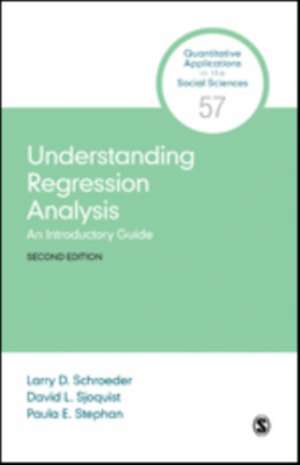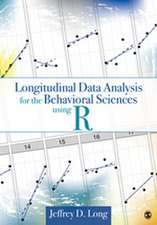Understanding Regression Analysis: An Introductory Guide: Quantitative Applications in the Social Sciences, cartea 57
Autor Larry D. Schroeder, David L. Sjoquist, Paula E. Stephanen Limba Engleză Paperback – 5 feb 2017
Din seria Quantitative Applications in the Social Sciences
-
 Preț: 306.08 lei
Preț: 306.08 lei -
 Preț: 270.02 lei
Preț: 270.02 lei -
 Preț: 270.25 lei
Preț: 270.25 lei -
 Preț: 274.06 lei
Preț: 274.06 lei -
 Preț: 270.29 lei
Preț: 270.29 lei -
 Preț: 304.51 lei
Preț: 304.51 lei -
 Preț: 304.83 lei
Preț: 304.83 lei -
 Preț: 313.80 lei
Preț: 313.80 lei -
 Preț: 305.60 lei
Preț: 305.60 lei -
 Preț: 306.14 lei
Preț: 306.14 lei -
 Preț: 273.46 lei
Preț: 273.46 lei -
 Preț: 275.42 lei
Preț: 275.42 lei -
 Preț: 277.33 lei
Preț: 277.33 lei -
 Preț: 305.05 lei
Preț: 305.05 lei -
 Preț: 305.32 lei
Preț: 305.32 lei -
 Preț: 304.77 lei
Preț: 304.77 lei -
 Preț: 305.05 lei
Preț: 305.05 lei -
 Preț: 304.51 lei
Preț: 304.51 lei -
 Preț: 305.28 lei
Preț: 305.28 lei -
 Preț: 304.51 lei
Preț: 304.51 lei -
 Preț: 305.60 lei
Preț: 305.60 lei -
 Preț: 304.77 lei
Preț: 304.77 lei -
 Preț: 306.14 lei
Preț: 306.14 lei -
 Preț: 306.34 lei
Preț: 306.34 lei -
 Preț: 305.40 lei
Preț: 305.40 lei -
 Preț: 306.41 lei
Preț: 306.41 lei -
 Preț: 304.77 lei
Preț: 304.77 lei -
 Preț: 305.60 lei
Preț: 305.60 lei -
 Preț: 269.91 lei
Preț: 269.91 lei -
 Preț: 289.18 lei
Preț: 289.18 lei -
 Preț: 287.82 lei
Preț: 287.82 lei -
 Preț: 316.12 lei
Preț: 316.12 lei -
 Preț: 288.96 lei
Preț: 288.96 lei -
 Preț: 316.71 lei
Preț: 316.71 lei -
 Preț: 314.98 lei
Preț: 314.98 lei -
 Preț: 317.26 lei
Preț: 317.26 lei -
 Preț: 314.60 lei
Preț: 314.60 lei -
 Preț: 289.95 lei
Preț: 289.95 lei -
 Preț: 289.18 lei
Preț: 289.18 lei -
 Preț: 315.36 lei
Preț: 315.36 lei -
 Preț: 314.98 lei
Preț: 314.98 lei -
 Preț: 314.38 lei
Preț: 314.38 lei -
 Preț: 316.33 lei
Preț: 316.33 lei -
 Preț: 316.51 lei
Preț: 316.51 lei -
 Preț: 314.76 lei
Preț: 314.76 lei -
 Preț: 288.41 lei
Preț: 288.41 lei -
 Preț: 316.51 lei
Preț: 316.51 lei
Preț: 304.51 lei
Nou
Puncte Express: 457
Preț estimativ în valută:
58.28€ • 60.33$ • 49.26£
58.28€ • 60.33$ • 49.26£
Carte disponibilă
Livrare economică 12-26 februarie
Livrare express 28 ianuarie-01 februarie pentru 21.20 lei
Preluare comenzi: 021 569.72.76
Specificații
ISBN-13: 9781506332888
ISBN-10: 1506332889
Pagini: 120
Dimensiuni: 140 x 216 x 2 mm
Greutate: 0.14 kg
Ediția:Second Edition
Editura: SAGE Publications
Colecția Sage Publications, Inc
Seria Quantitative Applications in the Social Sciences
Locul publicării:Thousand Oaks, United States
ISBN-10: 1506332889
Pagini: 120
Dimensiuni: 140 x 216 x 2 mm
Greutate: 0.14 kg
Ediția:Second Edition
Editura: SAGE Publications
Colecția Sage Publications, Inc
Seria Quantitative Applications in the Social Sciences
Locul publicării:Thousand Oaks, United States
Recenzii
“This is an excellent update; a clear and accessible introduction to a complex, yet very important, statistical method: regression analysis. The book can serve as a perfect supplement or stand-alone book in introductory social statistics courses.”
“Understanding Regression Analysis provides students at all levels a foundational understanding of multiple linear regression analysis through intuitive explanations and interdisciplinary examples aimed at elucidating concepts, approaches, and interpretations.”
“This monograph provides a clear and concise introduction to regression analysis concepts and procedures, with a problem-solving approach toward addressing common maladies of regression modeling.”
“The authors do a top-notch job of competently presenting a plethora of topics regarding regression analysis.”
“Understanding Regression Analysis provides students at all levels a foundational understanding of multiple linear regression analysis through intuitive explanations and interdisciplinary examples aimed at elucidating concepts, approaches, and interpretations.”
“This monograph provides a clear and concise introduction to regression analysis concepts and procedures, with a problem-solving approach toward addressing common maladies of regression modeling.”
“The authors do a top-notch job of competently presenting a plethora of topics regarding regression analysis.”
Cuprins
Series Editor’s Introduction
Preface
Acknowledgments
About the Authors
1. Linear Regression
Introduction
Hypothesized Relationships
A Numerical Example
Estimating a Linear Relationship
Least Squares Regression
Examples
The Linear Correlation Coefficient
The Coefficient of Determination
Regression and Correlation
Summary
2. Multiple Linear Regression
Introduction
Estimating Regression Coefficients
Standardized Coefficients
Associated Statistics
Examples
Summary
3. Hypothesis Testing
Introduction
Concepts Underlying Hypothesis Testing
The Standard Error of the Regression Coefficient
The Student’s t Distribution
Left-Tail Tests
Two-Tail Tests
Confidence Intervals
F Statistic
What Tests of Significance Can and Cannot Do
Summary
4. Extensions to the Multiple Regression Model
Introduction
Types of Data
Dummy Variables
Interaction Variables
Transformations
Prediction
Examples
Summary
5. Problems and Issues Associated With Regression
Introduction
Specification of the Model
Variables Used in Regression Equations and Measurement of Variables
Violations of Assumptions Regarding Residual Errors
Additional Topics
Conclusions
Appendix A: Derivation of a and b
Appendix B: Critical Values for Student’s t Distribution
Appendix C: Regression Output From SAS, Stata, SPSS, R, and EXCEL
Appendix D: Suggested Textbooks
References
Index
Preface
Acknowledgments
About the Authors
1. Linear Regression
Introduction
Hypothesized Relationships
A Numerical Example
Estimating a Linear Relationship
Least Squares Regression
Examples
The Linear Correlation Coefficient
The Coefficient of Determination
Regression and Correlation
Summary
2. Multiple Linear Regression
Introduction
Estimating Regression Coefficients
Standardized Coefficients
Associated Statistics
Examples
Summary
3. Hypothesis Testing
Introduction
Concepts Underlying Hypothesis Testing
The Standard Error of the Regression Coefficient
The Student’s t Distribution
Left-Tail Tests
Two-Tail Tests
Confidence Intervals
F Statistic
What Tests of Significance Can and Cannot Do
Summary
4. Extensions to the Multiple Regression Model
Introduction
Types of Data
Dummy Variables
Interaction Variables
Transformations
Prediction
Examples
Summary
5. Problems and Issues Associated With Regression
Introduction
Specification of the Model
Variables Used in Regression Equations and Measurement of Variables
Violations of Assumptions Regarding Residual Errors
Additional Topics
Conclusions
Appendix A: Derivation of a and b
Appendix B: Critical Values for Student’s t Distribution
Appendix C: Regression Output From SAS, Stata, SPSS, R, and EXCEL
Appendix D: Suggested Textbooks
References
Index
Notă biografică
Dr. Larry Schroeder, Professor of Public Administration Maxwell Professor of Teaching Excellence, and Senior Research Associate in the Moynihan Institute of Global Affairs at the Maxwell School, Syracuse University is a public finance economist with primary interest in state and local public finance and financial management. He has conducted research on a variety of state and local government fiscal issues both in the U.S. and abroad. Much of his current research is directed at public finance issues arising in developing and transition economies. He is
particularly interested in problems associated with financing the construction and maintenance of public infrastructure in these environments as well as the broader issues of decentralization, intergovernmental fiscal relations, and the effects of institutional arrangements on the provision of public services. He is the co-author of several books and has written a large number of articles addressing these subjects.
Professor Schroeder has consulted with and led policy research projects sponsored by the United States Agency for International Development, the World Bank, and the United Nations Capital Development Fund in numerous countries, especially in South and Southeast Asia, but also in Africa and Eastern Europe. In 1998-99 he was a Visiting Professor at Universiti Sains Malaysia in Penang Malaysia and was a Visiting Research Fellow at the National College of Public Administration and Governance at the University of the Philippines (Diliman Campus) in Quezon City, Philippines in 2005-06.
Professor Schroeder earned his Ph.D. in Economics from the University of Wisconsin in 1971. During the early 1970s he was on the economics faculty at Georgia State University. In 1977 he joined the Departments of Public Administration and Economics at the Maxwell School, Syracuse University and served here until 1994 when he was a Professor of Public and Environmental Affairs at Indiana University. He rejoined The Maxwell School faculty in 1998.
Descriere
Presents the fundamentals of regression analysis, from its meaning to uses, in a concise, easy-to-read, and non-technical style.





















